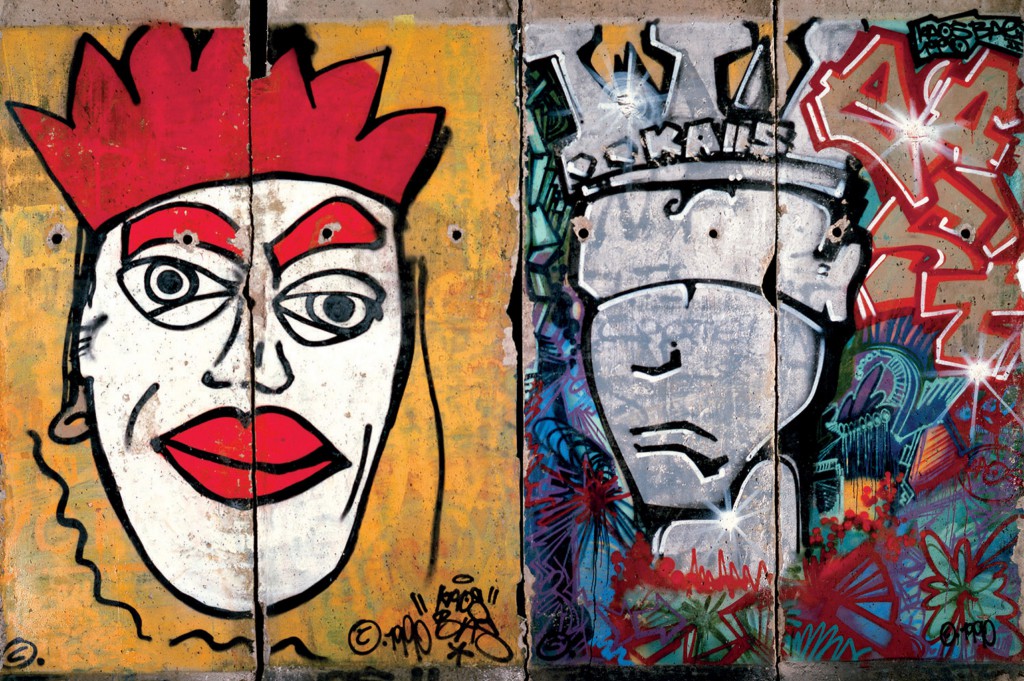When it comes to favorite art, I have an ever-growing list of guilty pleasures, a term which usually refers to some kind of light-hearted or even redeemable creation. Today, I’m not going to write about redemption in Taylor Swift’s new album (“It’s fun though…”). I’m more interested in the less redeemable batch, art that remains thoroughly, maybe explicitly, irreligious. Joyce’s A Portrait of the Artist as Young Man, for example, traces the loss of religion in a young man’s life but is resonant and powerful. Or, I’m thinking of James Ponsoldt’s The Spectacular Now, about two teenagers and the mistakes they make: the end. Or even the anonymous Berlin Wall art, representing free expression but also separation, anger, pain. All of this, of course, is good art, and that’s the problem. There’s passion and nuance; there’s chaos and cosmos; there is, more often than not, a perfect soundtrack or font selection or color scheme; there are no Christ figures.
I recently came across Walking on Water, Madeleine L’Engle’s reflections on faith and art. L’Engle authored the renowned children’s classic, A Wrinkle in Time, among other books, and maintains a daringly unconventional perspective on art:
Aeschylus writes, “In our sleep, pain that cannot forget falls drop by drop upon the heart and in our own despair, against our will, comes wisdom through the awful grace of God.” We see that wisdom and that awful grace in the silence of the Pieta; in Gerard Manley Hopkins’ poems; in Poulenc’s organ concerto; but we do not find it in many places where we would naturally expect to find it. This confusion comes about because much so-called religious art is in fact bad art, and therefore bad religion. Those angels rendered by grown-ups who obviously didn’t believe in angels…are only one example. Some of those soppy pictures of Jesus, looking like a tubercular, fair-haired, blue-eyed goy, are far more secular than a Picasso mother and child.
Perhaps problems reside less in a given artwork’s religious affiliations and more in the observer’s willingness to label it “Christian” or not. L’Engle touches on this:
…perhaps the reason I shuddered at the idea of writing something about “Christian art” is that to paint a picture or to write a story or to compose a song is an incarnational activity. The artist is a servant who is willing to be a birthgiver. In a very real sense the artist (male or female) should be like Mary who, when the angel told her that she was to bear the Messiah, was obedient to the command.”
To create art, in any form, is a spiritual activity. To create art is to acknowledge the existence of some deeper reality; to pull up to the surface something otherworldly.
L’Engle continues:
Stories, no matter how simple, can be vehicles of truth; can be, in fact, icons. It’s no coincidence that Jesus taught almost entirely by telling stories, simple stories dealing with the stuff of life familiar to the Jews of his day. Stories are able to help us to become more whole, to become Named. And Naming is one of the impulses behind all art; to give a name to the cosmos we see despite all the chaos.
God asked Adam to name all the animals, which was asking Adam to help in the creation of their wholeness. When we name each other, we are sharing in the joy and privilege of incarnation, and all great works of art are icons of Naming.
When we look at a painting, or hear a symphony, or read a book, and feel more Named, then, for us, that work is a work of Christian art. But to look at a work of art and then to make a judgment as to whether or not it is art, and whether or not it is Christian, is presumptuous. It is something we cannot know in any conclusive way. We can know only if it speaks within our own hearts, and leads us to living more deeply with Christ in God.
One of my professors, Dr. Caroline Gordon, a deeply Christian woman, told our class, “We do not judge great art. It judges us.” And that very judgment may enable us to change our lives, and to renew our commitment to the Lord of Creation.
L’Engle continues: “There is nothing so secular that it cannot be sacred, and that is one of the deepest messages of the Incarnation.”

COMMENTS
2 responses to “Unredeemable Art and Wise Words From Madeleine L’Engle”
Leave a Reply














I Love Madeleine L’Engle! I also love the concept that we can find the God Man in so many ” secular” things. God will reveal Himself to us if we only have eyes to see.
Loved this reflection. It reminded me of a famous passage from Thomas Merton’s Conjectures of a Guilty Bystander about a “revelation” he had in downtown Louisville (actually just a few blocks from where I now work):
“In Louisville, at the corner of Fourth and Walnut, in the center of the shopping district, I was suddenly overwhelmed with the realization that I loved all those people, that they were mine and I theirs, that we could not be alien to one another even though we were total strangers. It was like waking from a dream of separateness, of spurious self-isolation in a special world, the world of renunciation and supposed holiness… This sense of liberation from an illusory difference was such a relief and such a joy to me that I almost laughed out loud… I have the immense joy of being man, a member of a race in which God Himself became incarnate. As if the sorrows and stupidities of the human condition could overwhelm me, now I realize what we all are. And if only everybody could realize this! But it cannot be explained. There is no way of telling people that they are all walking around shining like the sun.”